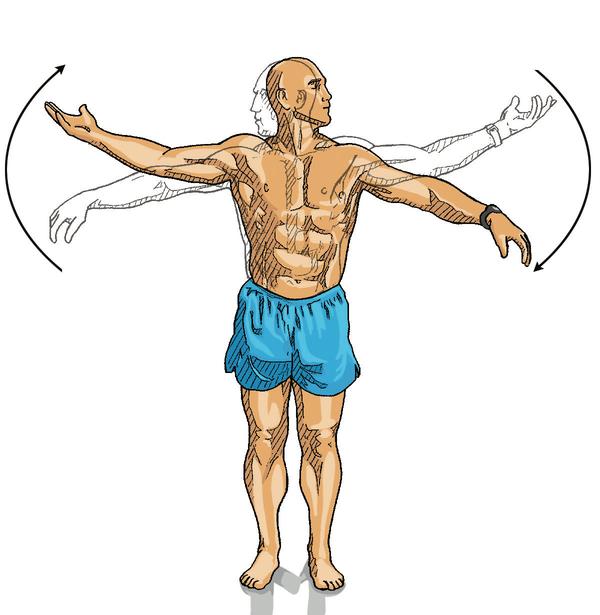Zone Exercises for Balancing Stress and Building Vitality Part 2
by Paul Chek

 Last week, in Part 1 of my short series on Zone Exercises, I discussed how you can increase your energy and vitality quickly and efficiently within minutes without leaving your home.
Last week, in Part 1 of my short series on Zone Exercises, I discussed how you can increase your energy and vitality quickly and efficiently within minutes without leaving your home.
Boosting your body’s ability to generate much needed energy and vitality in your body is a lot like investing. It takes a consistent investment of energy to generate the amounts necessary to dampen the toll stress takes on your body. That’s where Zone Exercises come in.
I explained why Zone Exercises work and provided a table that describes the different zones in the human body, the muscles that are affected and their related muscular and emotional connections.
In this final part, you’ll learn how to perform Zone Exercises, and have a sample of exercises from each zone to try on your own.
A Zone Exercise performance checklist
There are six different areas of the body, called Zones (refer to the table in Part 1 of this series). For those familiar with chakras, each Zone corresponds to a different chakra. This system is the foundation for yoga, tai chi, qi gong and Zone Exercises.
Before you select exercises, review this six-point Zone Exercise checklist to help you get started safely and smartly.
- Refer to the table to determine which areas and issues are problems and their corresponding Zones in your body. You may have musculoskeletal problems, such as pain, repeated injury or weakness in a particular area. Issues with one or more systems of your body may be a priority, such as high blood pressure, poor digestion, difficulty sleeping or hormonal fluctuations from menopause or menstruation. Alternatively, you may strongly identify with factors in the related issues column in the table — think financial stress — that could be major problems in your life right now. Prioritize the top three or four issues stemming from your body or an external source. (Many people discover these problems fall into one or two zones.)
- Try each exercise and choose the ones you feel are most effective. If you have more time, I recommend doing more than one because they don’t cause fatigue… They energize!
- Zone Exercises can be done any time. If you feel tired or sluggish, perform a Zone Exercise and your energy levels will likely increase. Performed before or after eating, Zone Exercises can improve digestion. These are good times to determine how much effort to use with Zone Exercises. If you are working too hard, your digestion will feel compromised. If you are exercising at the correct level for a Zone Exercise, your digestion will improve.
- When performing Zone Exercises, always remember that the faster you move your body, the slower chi energy moves. Conversely, the slower you move your body, the faster chi energy moves. By experimenting with Zone Exercises, you will soon experience this interesting phenomenon.
- If you’re trying to cut down on sugar, caffeine or any other unnatural energy boosters, you may find Zone Exercises generate more energy to compensate for the empty energy often provided by addictive substances.
- Zone Exercises can help you unwind. By performing Zone Exercises, you bring more chi into your body. If you have a hard time falling asleep or sleeping throughout the night, practice your Zone Exercises just before going to bed.
Chi is intelligent. It knows when to speed up specific cells and body systems and when to slow them down!
Zone Exercise samples
Now that you understand the major benefits of Zone Exercises and how to do them properly, try this small sample of exercises that energize the different Zones in your body.
Zone 1
Superman
- Start face down on the floor, or over a Swiss ball.
- Lift your left arm and right leg so that they are at about the same height. Your arm should be 45 degrees from your head with your thumb pointed up.
- Hold this position for as long as you can with good form (up to 10 seconds) and switch sides. Do five on each side.

Zone 2
Leg Tuck
- Lie on your back with your knees bent.
- Inhale, then draw your legs into chest as you exhale (you may open the legs to pull them in closer).
- Inhale again as you return your legs to the floor. Repeat 10 times slowly.

 Zone 3
Zone 3
Piston Breathing
- Standing in a relaxed posture, inhale deeply, allowing your belly to expand.
- Exhale forcefully through your nose. If you can’t breathe through your nose, exhale through your mouth while pursing your lips like a trumpet player.
- Inhale again slowly and repeat up to 100 exhalation pulses.
Zone 4
The Fish
- Lie back resting on your arms, then inhale, while picking your chest up as high as you can. Hold for 10 seconds then relax and repeat 10 times.
- If this is uncomfortable for you, stand with good posture, inhale and open your arms wide as if you’re flying like a bird with your palms up. Exhale and bring your arms back across your body.
 Zone 5
Zone 5
Thoracic Mobilization
- Hold your arms straight out to the side and stay relaxed.
- Inhale, then turn your right arm up and left arm down and look down at your left arm.
- When you naturally want to exhale, turn your head to the other side and reverse arm positions. Repeat 10 times on each side.

Zone 6
Alternate Nostril Breathing
- Plug one nostril with your finger or thumb.
- Breathe in through your open nostril (your chest should rise in the last third of your breath only). Breathe out through your nostril, keeping the other one plugged.
- Try to breathe in and out for the same amount of time (for example, five seconds in and five seconds out).
- Alternate nostrils with each complete breath or inhalation. Repeat 10 times on each side.
 Remember that the Zone Exercises listed here are just a very small sampling of the ones you can master. You’ll find many more of them in my book, How to Eat, Move and Be Healthy!
Remember that the Zone Exercises listed here are just a very small sampling of the ones you can master. You’ll find many more of them in my book, How to Eat, Move and Be Healthy!
Love and chi,
Paul


